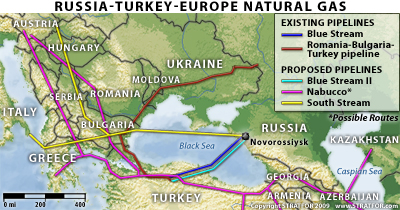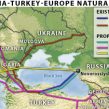
Little Substance in the Russo-Turkish Agreement on South Stream
Publication: Eurasia Daily Monitor Volume: 6 Issue: 153
By:

Putin’s visit and gas offer to Ankara is first and foremost intended as a counter-strike to the Nabucco project. The Nabucco inter-governmental agreement was signed, also in Ankara, on July 13 ("they barely had time to clean the red carpet" – Die Presse, August 7). Russia’s move is designed to inhibit European investment decisions on Nabucco through the suggestion that Russia would pre-empt Caspian gas reserves for its South Stream project. However implausible South Stream has been dubbed as a "Nabucco-killing project" in this sense, at least in intent.
Moreover, Putin’s move responds to the European Union’s recently growing involvement in the Ukrainian gas transit system through credits and technical assistance. Russia’s preferred option all along was to establish some form of control over Ukraine’s transit system, not to bypass it. Moscow began developing bypass options mainly as a form of pressuring Ukraine to yield control. As this goal seems to recede from view, Moscow is increasingly interested in bypass options such as South Stream and Blue Stream Two.
Moscow, however, never ruled out laying the South Stream pipeline through Ukraine’s exclusive economic zone, where construction costs would be considerably lower due to lesser depth and shorter distance from Russia to Bulgaria, compared with the route through the Turkish zone. The route through the Ukrainian zone would have to cross a portion of the Romanian exclusive economic zone in order to reach Bulgaria. In May of this year, Gazprom asked Romania to provide technical data on the Romanian zone and to allow Gazprom to survey the seabed, as an option for laying the South Stream pipeline there (EDM, May 28, 29).
Using the Romanian zone would only make sense if South Stream runs through the Ukrainian zone en route to Bulgaria. The Romanian zone is located between the Ukrainian zone and the Bulgarian zone. Romania gave a positive answer to Gazprom’s request. This indicates that Gazprom has not given up the Ukrainian option and may perhaps await the outcome of Ukraine’s 2010 elections, before determining South Stream’s route. Meanwhile, Gazprom is also signaling thereby that it is not entirely dependent on the Turkish seabed route for the South Stream project.
Romania’s role (like Turkey’s in the alternative scenario) would be limited to ensuring passage, although Moscow has hinted that Romania might later join the South Stream project as a partner. This overture is designed to signal that Moscow would consider bypassing Bulgaria through Romania, if the Bulgarian government develops reservations about South Stream’s cost-benefit ratio for Bulgaria. The new Bulgarian government has expressed such reservations on taking office, temporarily interrupting Bulgaria’s participation in the negotiations, pending a detailed review (EDM, August 6).
The route options as well as the gas volume offers remain largely academic, however, in the absence of resources and financing on the scale declared. Nevertheless, the Ankara event has triggered some confusion in the European media and another round of skeptical commentary on the fate of Nabucco, particularly in German and Austrian newspapers.
Italy’s state-controlled ENI oil and gas company is Gazprom’s partner in some aspects of the South Stream project, notably the underwater pipeline sections (Russia to Bulgaria and Greece to Italy), for which ENI offers the advanced technology. Attending the Ankara signing event, Italian Prime Minister Silvio Berlusconi and ENI CEO Paolo Scaroni portrayed South Stream as beneficial to Europe on the basis that it would circumvent the "unreliable" Ukraine (La Repubblica, Il Giornale, August 7, cited by Interfax, August 7). Berlusconi and ENI, among some other European energy business players, have uncritically adopted this Russian thesis, an alibi for supporting South Stream despite its adverse implications for the E.U.’s Nabucco and Southern Corridor projects.
At the Ankara signing event, Erdogan and Energy Minister Taner Yildiz expressed Turkey’s standard position that South Stream and Nabucco are not rival projects and that they can both coexist in Turkey. They also reaffirmed Ankara’s familiar position that Gazprom could join the Nabucco project, presumably without detriment to the E.U.’s supply diversification goals (Interfax, August 7; Anatolia news agency, August 4, 7, 8). Ankara hopes that Gazprom joining Nabucco would help maximize the gas volume in transit through Turkey. It would, however, negate Nabucco’s entire strategic rationale of supply diversification.
In an ideal case from Ankara’s standpoint, Turkey would end up with South Stream and Nabucco as the best-of-both-worlds situation. However, it is a high-risk action for Turkey to join Russia in hyping up South Stream. Although South Stream is a sheer political bluff in the form proposed, it may yet fulfill its Kremlin-designed political function of nipping Nabucco in the bud; and Turkey would, in that case, end up with neither project.




